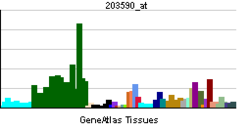- DYNC1LI2
-
Dynein, cytoplasmic 1, light intermediate chain 2 Identifiers Symbols DYNC1LI2; DNCLI2; LIC2 External IDs OMIM: 611406 MGI: 107738 HomoloGene: 4474 GeneCards: DYNC1LI2 Gene Gene Ontology Molecular function • nucleotide binding
• motor activity
• ATP bindingCellular component • cytoplasm
• centrosome
• cytoskeleton
• cytoplasmic dynein complex
• microtubuleBiological process • transport Sources: Amigo / QuickGO RNA expression pattern 
More reference expression data Orthologs Species Human Mouse Entrez 1783 234663 Ensembl ENSG00000135720 ENSMUSG00000035770 UniProt O43237 Q3UGJ3 RefSeq (mRNA) NM_006141 NM_001013380.2 RefSeq (protein) NP_006132 NP_001013398.2 Location (UCSC) Chr 16:
66.75 – 66.79 MbChr 8:
106.94 – 106.97 MbPubMed search [1] [2] Cytoplasmic dynein 1 light intermediate chain 2 is a protein that in humans is encoded by the DYNC1LI2 gene.[1][2]
References
- ^ Pfister KK, Fisher EM, Gibbons IR, Hays TS, Holzbaur EL, McIntosh JR, Porter ME, Schroer TA, Vaughan KT, Witman GB, King SM, Vallee RB (Nov 2005). "Cytoplasmic dynein nomenclature". J Cell Biol 171 (3): 411–3. doi:10.1083/jcb.200508078. PMC 2171247. PMID 16260502. http://www.pubmedcentral.nih.gov/articlerender.fcgi?tool=pmcentrez&artid=2171247.
- ^ "Entrez Gene: DYNC1LI2 dynein, cytoplasmic 1, light intermediate chain 2". http://www.ncbi.nlm.nih.gov/sites/entrez?Db=gene&Cmd=ShowDetailView&TermToSearch=1783.
Further reading
- Hughes SM, Vaughan KT, Herskovits JS, Vallee RB (1995). "Molecular analysis of a cytoplasmic dynein light intermediate chain reveals homology to a family of ATPases.". J. Cell. Sci. 108 ( Pt 1): 17–24. PMID 7738094.
- Chagnon P, Michaud J, Mitchell G, et al. (2003). "A missense mutation (R565W) in cirhin (FLJ14728) in North American Indian childhood cirrhosis.". Am. J. Hum. Genet. 71 (6): 1443–9. doi:10.1086/344580. PMC 378590. PMID 12417987. http://www.pubmedcentral.nih.gov/articlerender.fcgi?tool=pmcentrez&artid=378590.
- Strausberg RL, Feingold EA, Grouse LH, et al. (2003). "Generation and initial analysis of more than 15,000 full-length human and mouse cDNA sequences.". Proc. Natl. Acad. Sci. U.S.A. 99 (26): 16899–903. doi:10.1073/pnas.242603899. PMC 139241. PMID 12477932. http://www.pubmedcentral.nih.gov/articlerender.fcgi?tool=pmcentrez&artid=139241.
- Ota T, Suzuki Y, Nishikawa T, et al. (2004). "Complete sequencing and characterization of 21,243 full-length human cDNAs.". Nat. Genet. 36 (1): 40–5. doi:10.1038/ng1285. PMID 14702039.
- Beausoleil SA, Jedrychowski M, Schwartz D, et al. (2004). "Large-scale characterization of HeLa cell nuclear phosphoproteins.". Proc. Natl. Acad. Sci. U.S.A. 101 (33): 12130–5. doi:10.1073/pnas.0404720101. PMC 514446. PMID 15302935. http://www.pubmedcentral.nih.gov/articlerender.fcgi?tool=pmcentrez&artid=514446.
- Gerhard DS, Wagner L, Feingold EA, et al. (2004). "The status, quality, and expansion of the NIH full-length cDNA project: the Mammalian Gene Collection (MGC).". Genome Res. 14 (10B): 2121–7. doi:10.1101/gr.2596504. PMC 528928. PMID 15489334. http://www.pubmedcentral.nih.gov/articlerender.fcgi?tool=pmcentrez&artid=528928.
- Beausoleil SA, Villén J, Gerber SA, et al. (2006). "A probability-based approach for high-throughput protein phosphorylation analysis and site localization.". Nat. Biotechnol. 24 (10): 1285–92. doi:10.1038/nbt1240. PMID 16964243.
- Olsen JV, Blagoev B, Gnad F, et al. (2006). "Global, in vivo, and site-specific phosphorylation dynamics in signaling networks.". Cell 127 (3): 635–48. doi:10.1016/j.cell.2006.09.026. PMID 17081983.
Categories:- Human proteins
- Chromosome 16 gene stubs
Wikimedia Foundation. 2010.
